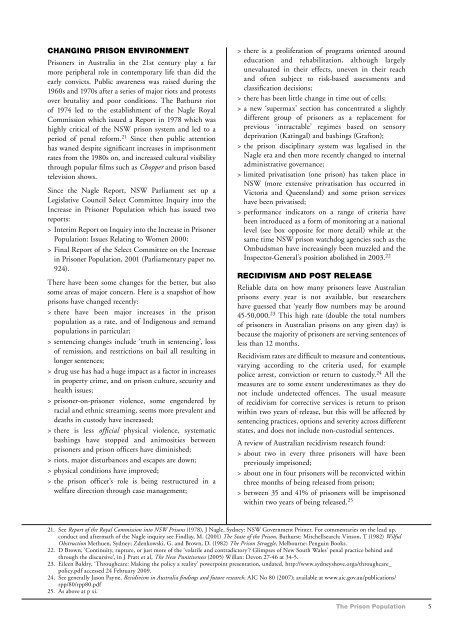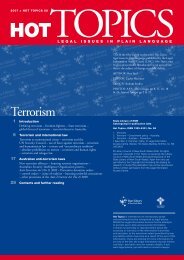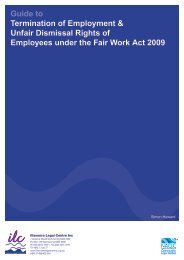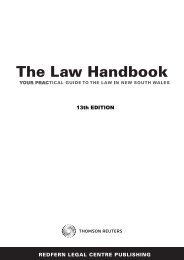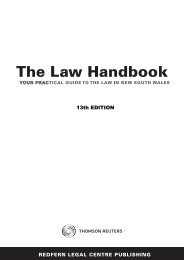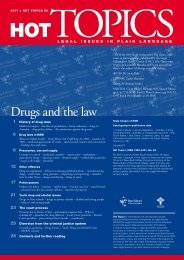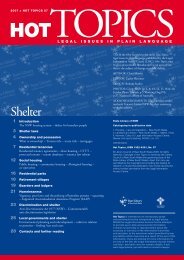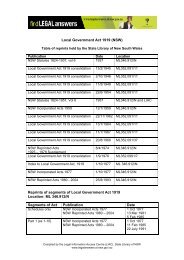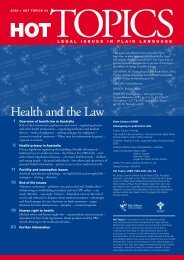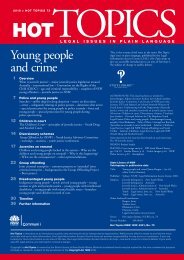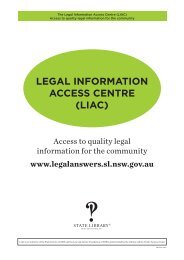Prisoners - Legal Information Access Centre - NSW Government
Prisoners - Legal Information Access Centre - NSW Government
Prisoners - Legal Information Access Centre - NSW Government
Create successful ePaper yourself
Turn your PDF publications into a flip-book with our unique Google optimized e-Paper software.
cHAnging prisOn envirOnmenT<br />
<strong>Prisoners</strong> in Australia in the 21st century play a far<br />
more peripheral role in contemporary life than did the<br />
early convicts. Public awareness was raised during the<br />
1960s and 1970s after a series of major riots and protests<br />
over brutality and poor conditions. The Bathurst riot<br />
of 1974 led to the establishment of the Nagle Royal<br />
Commission which issued a Report in 1978 which was<br />
highly critical of the <strong>NSW</strong> prison system and led to a<br />
period of penal reform. 21 Since then public attention<br />
has waned despite significant increases in imprisonment<br />
rates from the 1980s on, and increased cultural visibility<br />
through popular films such as Chopper and prison based<br />
television shows.<br />
Since the Nagle Report, <strong>NSW</strong> Parliament set up a<br />
Legislative Council Select Committee Inquiry into the<br />
Increase in Prisoner Population which has issued two<br />
reports:<br />
> Interim Report on Inquiry into the Increase in Prisoner<br />
Population: Issues Relating to Women 2000;<br />
> Final Report of the Select Committee on the Increase<br />
in Prisoner Population, 2001 (Parliamentary paper no.<br />
924).<br />
There have been some changes for the better, but also<br />
some areas of major concern. Here is a snapshot of how<br />
prisons have changed recently:<br />
> there have been major increases in the prison<br />
population as a rate, and of Indigenous and remand<br />
populations in particular;<br />
> sentencing changes include ‘truth in sentencing’, loss<br />
of remission, and restrictions on bail all resulting in<br />
longer sentences;<br />
> drug use has had a huge impact as a factor in increases<br />
in property crime, and on prison culture, security and<br />
health issues;<br />
> prisoner-on-prisoner violence, some engendered by<br />
racial and ethnic streaming, seems more prevalent and<br />
deaths in custody have increased;<br />
> there is less official physical violence, systematic<br />
bashings have stopped and animosities between<br />
prisoners and prison officers have diminished;<br />
> riots, major disturbances and escapes are down;<br />
> physical conditions have improved;<br />
> the prison officer’s role is being restructured in a <br />
welfare direction through case management;<br />
> there is a proliferation of programs oriented around<br />
education and rehabilitation, although largely<br />
unevaluated in their effects, uneven in their reach<br />
and often subject to risk-based assessments and<br />
classification decisions;<br />
> there has been little change in time out of cells;<br />
> a new ‘supermax’ section has concentrated a slightly<br />
different group of prisoners as a replacement for<br />
previous ‘intractable’ regimes based on sensory<br />
deprivation (Katingal) and bashings (Grafton);<br />
> the prison disciplinary system was legalised in the<br />
Nagle era and then more recently changed to internal<br />
administrative governance;<br />
> limited privatisation (one prison) has taken place in<br />
<strong>NSW</strong> (more extensive privatisation has occurred in<br />
Victoria and Queensland) and some prison services<br />
have been privatised;<br />
> performance indicators on a range of criteria have<br />
been introduced as a form of monitoring at a national<br />
level (see box opposite for more detail) while at the<br />
same time <strong>NSW</strong> prison watchdog agencies such as the<br />
Ombudsman have increasingly been muzzled and the<br />
Inspector-General’s position abolished in 2003. 22<br />
recidivism And pOsT releAse<br />
Reliable data on how many prisoners leave Australian<br />
prisons every year is not available, but researchers<br />
have guessed that ‘yearly flow numbers may be around<br />
45-50,000. 23 This high rate (double the total numbers<br />
of prisoners in Australian prisons on any given day) is<br />
because the majority of prisoners are serving sentences of<br />
less than 12 months.<br />
Recidivism rates are difficult to measure and contentious,<br />
varying according to the criteria used, for example<br />
police arrest, conviction or return to custody. 24 All the<br />
measures are to some extent underestimates as they do<br />
not include undetected offences. The usual measure<br />
of recidivism for corrective services is return to prison<br />
within two years of release, but this will be affected by<br />
sentencing practices, options and severity across different<br />
states, and does not include non-custodial sentences.<br />
A review of Australian recidivism research found:<br />
> about two in every three prisoners will have been<br />
previously imprisoned;<br />
> about one in four prisoners will be reconvicted within<br />
three months of being released from prison;<br />
> between 35 and 41% of prisoners will be imprisoned<br />
within two years of being released. 25<br />
21. See Report of the Royal Commission into <strong>NSW</strong> Prisons (1978), J Nagle, Sydney: <strong>NSW</strong> <strong>Government</strong> Printer. For commentaries on the lead up,<br />
conduct and aftermath of the Nagle inquiry see Findlay, M. (2001) The State of the Prison, Bathurst: Mitchellsearch; Vinson, T (1982) Wilful<br />
Obstruction Methuen, Sydney; Zdenkowski, G. and Brown, D. (1982) The Prison Struggle, Melbourne: Penguin Books.<br />
22. D Brown, ‘Continuity, rupture, or just more of the ‘volatile and contradictory’? Glimpses of New South Wales’ penal practice behind and<br />
through the discursive’, in J Pratt et al, The New Punitiveness (2005) Willan: Devon 27-46 at 34-5.<br />
23. Eileen Baldry, ‘Throughcare: Making the policy a reality’ powerpoint presentation, undated, http://www.sydneyshove.orga/throughcare_<br />
policy.pdf accessed 24 February 2009.<br />
24. See generally Jason Payne, Recidivism in Australia findings and future research, AIC No 80 (2007); available at www.aic.gov.au/publications/<br />
rpp/80/rpp80.pdf<br />
25. As above at p xi.<br />
the prison population 5


